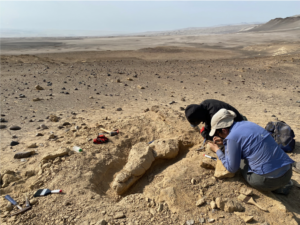Gavialoidea is a clade of slender- and long-snouted crocodylomorphs with a single living species, the Indian gharial Gavialis gangeticus. Because elongated snouts (longirostry) have evolved independently in several crocodylomorph clades, this head shape has been interpreted as an ecological adaptation. How this condition affected patterns of diversification and how longirostrine-associated cranial features changed through adaptive radiations remain poorly understood. Two new small gryposuchine gavialoids, Dadagavialis gunai gen. et sp. nov. (early Miocene, Panama) and Aktiogavialis caribesi sp. nov. (late Miocene, Venezuela), evidence remarkable Miocene diversification of longirostrine forms in the Neotropics and support transmarine biogeographical relations between northern South America, the Caribbean, and southernmost North America before the Isthmus of Panama was fully established. By integrating phylogenetics and geometric morphometrics, we focus on this gavialoid diversity to investigate patterns of longirostry across the crown group of crocodylomorphs (Crocodylia). Analyses revealed that the snout shape of gavialoids has occupied a small, distinct and almost invariable morphospace since the Cretaceous, in contrast with the morphologically labile snout shape of other crocodylians (crocodyloids and alligatoroids). Our results suggest iterative environmental shift occupations throughout gavialoid evolution without major changes in snout proportions, but involving conspicuous rearrangements of the circumorbital bones. The longirostrine gavialoid morphotype is a distinct adaptation for seizing small prey and typically includes short and wide premaxillae and enlarged ‘caniniform’ teeth only at the tip of the snout. In longirostrine crocodyloids (Tomistoma, Crocodylus intermedius), the conservation of powerful bites and ‘caniniforms’ closer to the jaw joints allowed them to exploit a wider range of prey sizes, which could explain their snout shape plasticity. Therefore, the Mio–Pliocene extirpation of gryposuchine gavialoids from the Caribbean by the arrival of Crocodylus is quite unlikely. The last gryposuchine survived throughout the Pliocene in the south-eastern Pacific, where Crocodylus has never been documented.



